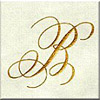The Engraving Process: Making Engraved Stationery
Engraved stationery is made by stamping fine, soft paper, preferably with a high cotton rag content, into an ink-filled etched plate under great pressure. It is an old process developed in the 1600's, to give a high quality appearance to important documents.
In the beginning all work was done by hand. The image was carefully hand-tooled into a metal plate by expert craftsmen. Nowadays, the image is computer typeset and engraved into a metal (usually copper) plate by acid etching after photographic exposure. This photoengraving process allows us to reproduce any image provided us with exact precision.
The etched plate is now placed in a special die-stamping press. Ink is drawn over the plate and wiped leaving the ink in the etched depressions of the image. Paper is positioned over the plate and stamped. The paper deforms into the etched cavities, picking up the ink. Once the ink is dried you have a finished engraved piece.
The beauty of engraved stationery lies in the contrasting thick and thin lines, and the three-dimensional quality of the lettering. If you look closely, you'll see a bruise surrounding the letters. This is a result of the stamping pressure, and gives engraving its unique character. While the letters are raised the paper around the letters is flattened producing a sharply contrasting image.


